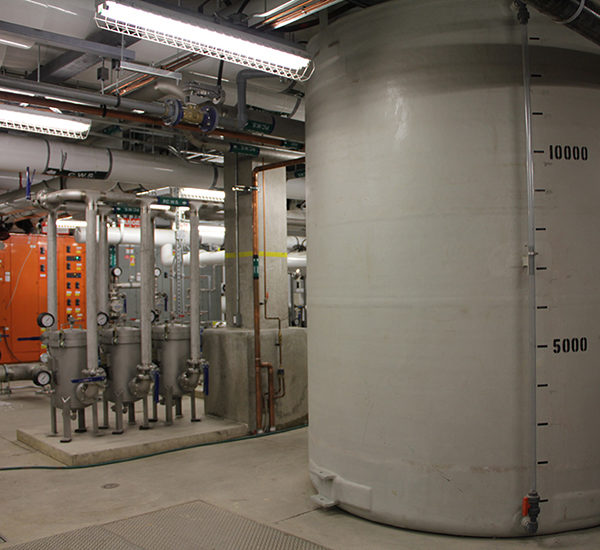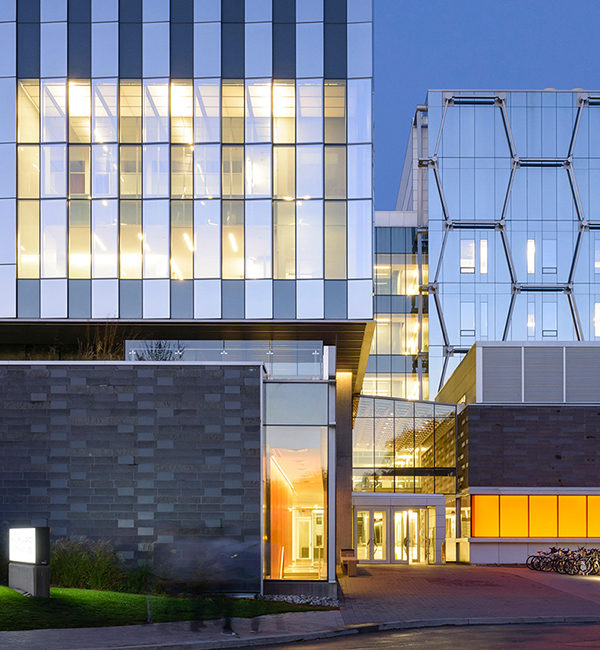Sector: Education
Toronto Metropolitan University (formerly Ryerson)
Mattamy Athletic Centre
This redevelopment project included a 225,632 ft2 athletic facility incorporating an NHL-sized ice rink with seating for 2,796, a multi-purpose court with 1,000+ seats, a fitness centre, studios and a high performance gym.
Elevating devices in this facility are readily available for public use and consist of two passenger elevators and three escalators. One large freight elevator (suitable for moving the ice-resurfacer) and a single Type B Material Lift were provided to manage the material handling requirements of the facility.
HH Angus provided Vertical Transportation Design Consulting to assist the architect in the design and selection of elevating devices for the Toronto Metropolitan University portion of this facility.
Photo credit: Toronto Metropolitan University
SERVICES
Vertical Transportation Design
PROJECT FEATURES
Size: 225,632 ft2 | Status: Completed 2012
LOCATION
Toronto, Ontario
KEY SCOPE ELEMENTS
2 passenger elevators | 3 escalators | l large freight elevator | Type B Material Lift
University of Waterloo
Mike & Ophelia Lazaridis Quantum Nano Centre
To understand how small a single nanometre is (one billionth of a metre), one hair on your head is approximately 80,000 nanometres in diameter. A strand of your DNA is only 2 nanometres wide.
The Quantum Nano building features state-of the-art laboratories for Nanotechnology research, ion and atom trapping, nuclear magnetic resonance, low temperature superconductivity, quantum optical research and a suite of clean rooms for fabrication and testing of quantum and nanotechnology devices.
The building was not just innovative, it was completely unique in Canada. The type of research, science and learning taking place here is at the leading edge of nanotechnology science.
With rapid advances in science, HH Angus had to be proactive to ensure that the building’s lab infrastructure was flexible enough to serve both today’s researchers and future scientific endeavours.
We continued to collaborate and communicate long after our formal role on the project had ended. There were significant challenges in the operation of such a sensitive and complex building. We extended our involvement to train the Centre's operations staff and teach them how to tune the systems. For well over a year of support, we taught and solved issues that resulted in no changes to the design, simply passing on the knowledge of how to operate the building and how to diagnose clues to optimize performance. HH Angus’ dedicated team of engineers sees each of our building projects as a legacy for our client.
SERVICES
Mechanical Engineering | Electrical Engineering | Security & Communications | Vertical Transportation Design
PROJECT FEATURES
Size: 285,000 ft2 | Status: Completed 2013
LOCATION
Waterloo, Ontario
KEY SCOPE ELEMENTS
Flexible design to serve future lab programs | Precision temperature control | UPS | Filtered electrical power

Ground-breaking facilities
The Quantum Nano Centre and its infrastructure is recognized as a ground-breaking building able to support ground-breaking research, teaching and science.
Design excellence
The highly technical facility required not only high precision temperature, humidity, filtered electrical power, uninterrupted power supplies, but also the mechanical, electrical and communications infrastructure that would meet the architectural and structural requirements.


Stakeholder involvement
This project was executed under the watchful eyes of multiple stakeholders. There was ongoing collaboration between the building department, university user groups and supervisors, international leaders in quantum computing and nanotechnology, as well as donors.
Queen’s University
Reactor Materials Testing Laboratory
“The facility provides a unique capability in Canada to support the development of materials for advanced reactor systems, and to improve our understanding of materials in use in existing reactors.”
– Rick Holt, Professor of Mechanical and Materials Engineering, Queen’s University
HH Angus has a long-standing and highly-valued relationship with Queen’s University, spanning many years and many diverse areas of the campus. For this project, we were engaged to provide mechanical and electrical engineering design services for the University’s new Reactor Materials Testing Laboratory (RTML). The RMTL is an exciting research endeavour for the Queen’s Nuclear Materials Group. It uses a proton accelerator to introduce damage into materials at a microscopic scale.
HH Angus was the M+E engineer for the specialized laboratory building. With TEM* and SEM** rooms requiring critical temperature and humidity control, and HVEE linear accelerator room, this building is a ‘function drives form’ project, with the laboratory equipment dictating all the infrastructure services and spaces. Significant time was spent to ensure appropriate services could be accommodated after the delivery of the equipment and to allow for changes in services that may occur with changing equipment.
The 8000 ft2 facility was custom designed to house electron microscopes and a linear accelerator for a specific research program. A highly specialized building, with toxic gas and radiation protection, the site features an accelerator hall, control room, services rooms, laboratories for specimen preparation and characterization, and working space for researchers.
A significant challenge that our team overcame was the design of mechanical and electrical building services that need to pass through the one-metre thick bunker walls for the linear accelerator room. The walls contain stray electrons, the potential for which also required the use of non-conductive chilled water.
*Transmission electron microscopy (TEM) is a microscopy technique whereby a beam of electrons is transmitted through an ultra-thin specimen
** A scanning electron microscope (SEM) produces images of a sample by scanning it with a focused beam of electrons
SERVICES
Mechanical Engineering
PROJECT FEATURES
Size: 8,000 ft2 | Status: Completed 2013
LOCATION
Kingston, Ontario
KEY SCOPE ELEMENTS
Specialized laboratory building | Critical temperature and humidity control | Toxic gas and radiation protection | M&E building services had to pass through one-metre thick bunker walls
University of Waterloo
Humanities Chiller Plant
HH Angus provided prime consulting engineering services for mechanical, electrical and structural design, project management, and construction administration services for this new Chiller Plant at the University of Waterloo.
The installation included two new 1000 ton, low-pressure centrifugal chillers, two new 1000 ton induced draft cooling towers, associated ancillary equipment, an emergency refrigeration ventilation system, and a chiller plant control system.
The electrical design featured new electrical infrastructure to accommodate the addition of new switch gear, transformers and electrical distribution to all ancillaries.
We used Bentleys Autoplant 3D software for the mechanical piping and ventilation design to ensure the functionality of the equipment and piping layout design. We also provided our client with documentation for pre-tendering of chillers and assisted in evaluation of the tenders.
As Prime Consultant, we engaged a structural engineer to design the necessary infrastructure on the roof to support the new cooling towers.
SERVICES
Prime Consultant | Mechanical Engineering | Electrical Engineering | Contract Administration
PROJECT FEATURES
Status: Completed 2011
LOCATION
Waterloo, Ontario
KEY SCOPE ELEMENTS
Installation of two new 1000 ton low pressure centrifugal chillers | Two new 1000 ton induced draft cooling towers | Emergency refrigeration ventilation system | Structural design to support new infrastructure for cooling towers | Bentleys Autoplant 3D to ensure functionality
Queen’s University
Tindall Playing Field Relocation & Parking Structure
“The opening of Tindall Field is the first step for Queen's Athletics in moving towards our vision of becoming the best in Canada.”
– Leslie Dal Cin, Director of Athletics and Recreation, Queen’s News Centre Sept. 2008
Kingston, Ontario’s first outdoor artificial playing surface, Tindall Field at Queen’s University, was developed as a two-level underground parking structure and a running track and Soccer/Football Playing Field. The roof of the parking structure forms the base of the playing field, and includes a playing field storm drainage system that directs the storm water to a large cistern for flow control into the municipality’s storm drainage system. The field is surrounded by a 3-lane rubberized track.
Resolving light pollution issues was critical, given the proximity of the field to a student residence and the campus observatory. Lighting consisted of pole-mounted luminaires on each side of the playing field. The light distribution was controlled by designing shields for the upward lighting component and reflectors with cut-offs to reduce light distribution at the edge of the playing field.
SERVICES
Mechanical Engineering | Electrical Engineering | Lighting
PROJECT FEATURES
Status: Completed 2008
LOCATION
Kingston, Ontario
KEY SCOPE ELEMENTS
Playing field over underground parking | Rubberized running track | Storm drainage system with large cistern for flow control |Specialized light distribution control
